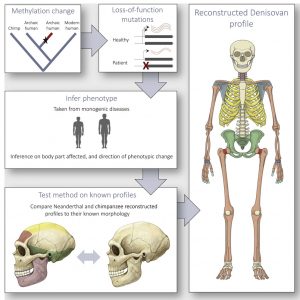Denisovans lived 100,000 years ago and never, to our knowledge, sat for portraits. Nevertheless, some of their characteristic features have been captured by scientists at the Hebrew University of Jerusalem (HUJI). Analyzing DNA extracted from scant remains—a single fingertip—the scientists gathered DNA methylation data that allowed them to sketch an anatomical profile for Denisovans. To help bring the profile to life, the scientists arranged for their work to inform an artist’s conception of a juvenile female Denisovan.
She has an elongated face, like that of a Neanderthal. But she also has features unique to Denisovans. For example, she has an increased dental arch and a lateral cranial expansion. Not all the features uncovered by the HUJI scientists are skull features. The scientists also considered how DNA methylation patterns may have influenced other parts of the Denisovan body, including the pelvis (wide), femoral articulations (large), and the ribcage (also large).
“We provide the first reconstruction of the skeletal anatomy of Denisovans,” says Liran Carmel, a professor at HUJI’s Institute of Life Sciences. “In many ways, Denisovans resembled Neanderthals, but in some traits, they resembled us. In others, they were unique.”
Carmel is the senior author of an article (“Reconstructing Denisovan Anatomy Using DNA Methylation Maps”) that appears September 19 in Cell. The article describes how Carmel and colleagues compared DNA methylation patterns from Denisovans, Neanderthals, and modern humans to find genomic regions that differed epigenetically. Specifically, the scientists looked for different patterns of DNA methylation.
DNA methylation is a kind of chemical modification that can affect a gene’s activity without changing its underlying DNA sequence, and some DNA methylation patterns have been related to physiology—and physiognomy. For example, DNA methylation patterns are known to cause genes to lose their functions. Extrapolating from this kind of knowledge, the linking of “unidirectional methylation changes to loss-of-function phenotypes,” the Carmel and colleagues devised a method to reconstruct skeletal morphologies.
When the scientists tested their method, they found that roughly 85% of their trait reconstructions were accurate in predicting which traits diverged and in which direction they diverged. Encouraged by these results, the scientists applied their method to Denisovans.
“Overall, we identified 56 traits in which the Denisovan is expected to be different from modern humans or Neanderthals, and in 32, we were able to predict a direction of change,” the article’s authors report. “The 32 unidirectional traits allowed us to suggest a reconstruction of Denisovan skeletal features. As expected, most Denisovan traits (21 out of 32) are predicted to be shared with the Neanderthal.”

While the paper was in review, another study came out describing the first confirmed Denisovan mandible. And it turned out that the jawbone matched the HUJI team’s predictions.
“Our predictions match the only morphologically informative Denisovan bone to date, as well as the Xuchang skull, which was suggested by some to be a Denisovan,” the article’s authors emphasized. “We conclude that DNA methylation can be used to reconstruct anatomical features, including some that do not survive in the fossil record.”
Denisovan remains were first discovered in 2008 and have fascinated human evolution researchers ever since. The Denisovans lived in Siberia and Eastern Asia, and they went extinct approximately 50,000 years ago. We don’t yet know why. That said, up to 6% of present-day Melanesians and Aboriginal Australians contain Denisovan DNA. Further, Denisovan DNA likely contributed to modern Tibetans’ ability to live in high altitudes and to Inuits’ ability to withstand freezing temperatures.
The traits identified in the current study raise additional questions. Do the traits shed light on the Denisovan lifestyle? Could they explain how Denisovans survived the extreme cold of Siberia?
“There is still a long way to go to answer these questions,” Carmel noted. “But our study sheds light on how Denisovans adapted to their environment and highlights traits that are unique to modern humans and which separate us from these other, now extinct, human groups.” According to Carmel, studying Denisovan anatomy could teach us about human adaptation, evolutionary constraints, development, gene-environment interactions, and disease dynamics. “At a more general level,” he pointed out, “this work is a step towards being able to infer an individual’s anatomy based on their DNA.”



